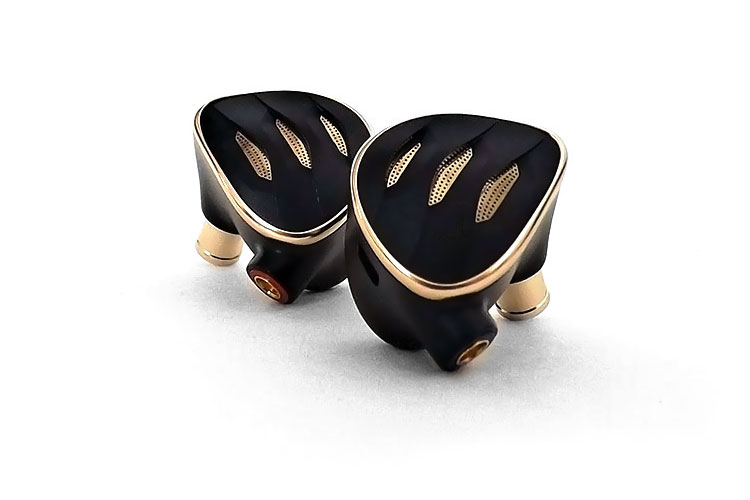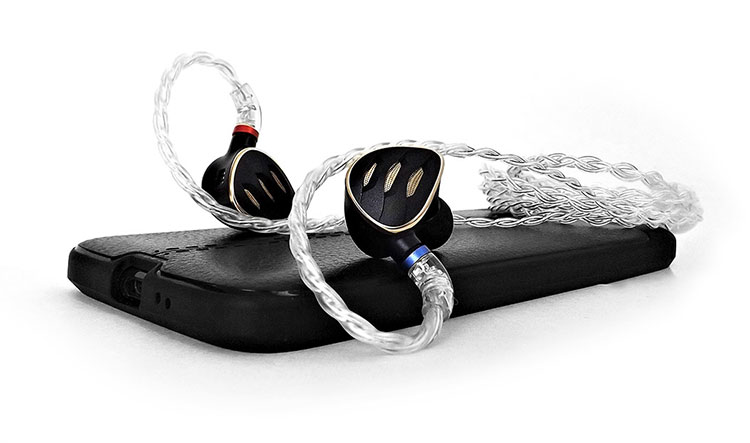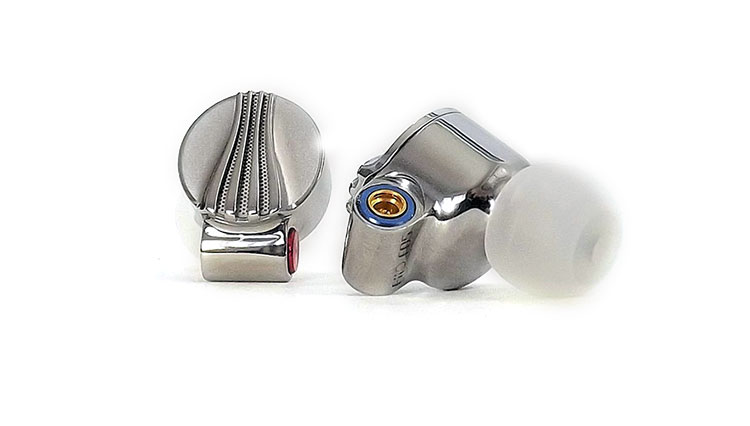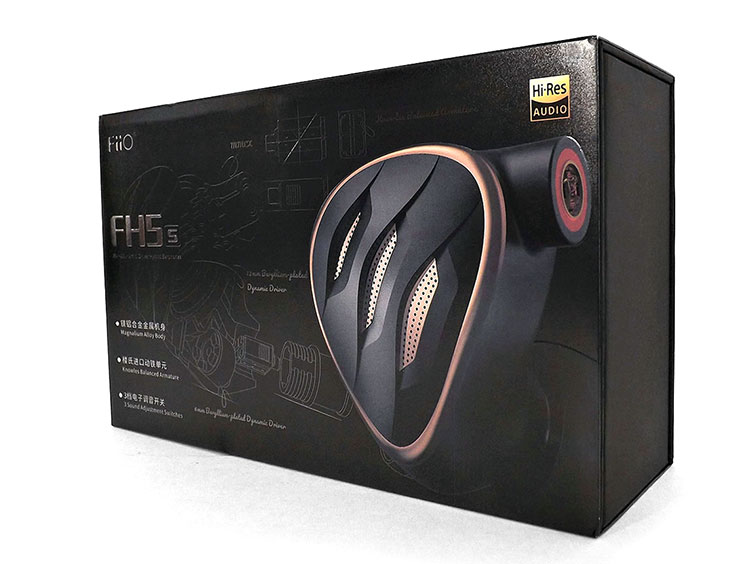Sound Impressions
Initial Listening
The FiiO FH5s give the first impression of being exceptionally large and dynamic with a punchy sound signature while remaining relatively neutral through the frequency spectrum except for a small dip in the midrange.
However, even with that dip, I would not consider these V or U-shaped although they certainly look that way on FiiO’s supplied frequency response graph and you could always raise the midrange output with the flick of a switch.
The midrange seems to have a medium forwardness, brightness and tonality seem very good. The high frequencies are more forward and are not shy at all so if the recording is bright, you might get a blast of edginess and metallic splashiness which is common on some BA tweeters especially if you push them too hard.
Contrary, the bass seems to be comfortable with an ample amount of boost and when the music demands low bass rumble performance the FiiO FH5s presents no low bass distortion even at very loud volume levels.
FiiO recommends breaking these in and I did for around 40 hours before I made a sound judgment plus I found the foam tips to be best for me and the stock-installed tips second, but you will have to find your own that works for you. Bass will suffer if you do not obtain a good seal.
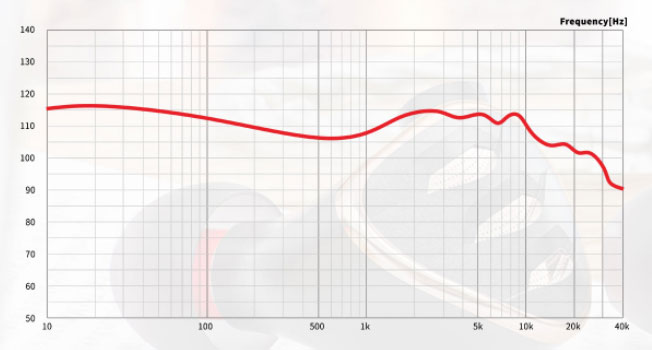
Frequency Spectrum
Let us take the FiiO FH5s from bottom to top. That bass driver can tickle your eardrums for sure. The low bass response is very good. It takes a considerable amount of volume and bass boost to distort the driver and by then, your eardrum will be begging for mercy. The bass digs deep, sounds quick, and with plenty of definition with lots of energy down under.
I ran a tone sweep and found the bass to be very flat down to 22Hz but it dips perhaps 2 decibels at 20 Hz and still audible to 16 Hz where below that frequency the output to me takes a dive at around my audible limit of 14 Hz.
Tonal balance was good and relatively flat but I heard a small rise in output at around 1.5 kHz. I also detected some very small peaks at 5 and at 7 kHz but those particular peaks did not become too problematic in a listening session.
These peaks only added some presence. The midrange section which benefits from this presence produces tons of background detail and they bring out lots of the subtle background sounds a tad forward.
Volume and frequency balance is fairly linear until you decide to raise the volume to what I consider very loud, then the high frequencies become somewhat intense and some people might not find them soothing and especially around the 4k to 8k region. At medium and even at a moderately high volume level most frequency bands stay fairly coherent, smooth, and true in tonality.
Musicality
Musicality is about enjoyment, emotion and the FiiO FH5s give me that. They are not flat and do have some color but I had to work on them.
An example I can give is while listening to Arctic Monkeys Tranquility Base and Casino which usually sounds smooth, expansive, and spacey. It does have an edginess I am not fond of until I started looking hard at the frequency graph and made some tweaks accordingly.
I lowered every frequency band 3 decibels in a flat plain starting at around 2 kHz and up to the end of the frequency bands and bam. Everything fell in place and I could finally enjoy these even more so than other IEMs in the same price bracket.
With an adjustment in equalization of reduction and not addition along with the bass switch on they became punchy but smooth, engaging and most of all those high not only became tolerable but became enjoyable with lots of clarity and detail. The experience with the FH5s became warm and inviting.
I went to a track called Wake Up Call on Chinese Butterfly by the Steve Gadd Band and the late great maestro Chick Corea. The song was beautifully portrayed by the FH5s giving me plenty of width and airiness with great imaging.
Then a change occurs that you clearly feel on the FH5s and around the intro of the drum into the track where it then transitioned into a very noticeable studio closed-in feel. The drum kick felt very real and everything had a good sense of cleanliness overall within the track, not overly sterile, with even the cymbals sounding very clean and crisp.
Staging
Off the bat, the FiiO FH5s felt wide and spacious, and I did expect that even knowing they had a semi-open design. The 3D panorama was all there, depth, height, and width.
Positioning is fairly tight and precise and I would consider staging a strong virtue of the FH5s. The left to right shifting plain is accurate as can be plus the FH5s can do 3D positioning off each side but not so much center stage which is okay and fairly realistic to me.
Can I point one aspect of the staging I dislike? Not really. Side staging seemed larger than center staging which although they have the ability to 3D position well almost anywhere in the sound panorama the occupied frontal space seemed smaller and more direct than the sides. I actually prefer that over a diffused frontal stage.
Synergy
The FiiO FH5s is very efficient and can be driven by most phones to acceptably loud levels but also feel at home if you want to give them some serious power which I consider to be unnecessary with this particular IEM.
I just feed them clean power with a good source. Perhaps one should feed them with a warm amplifier as a preference to obtain the best results since the treble can be quite forward.
Since the FiiO FH5s has switches to play with the sound signature I guess it is safe to say the user must go into discovery mode to find their own sweet spot with these and mine was found once I did the above, but you might disagree and find other settings best for you.
Some might find this sound alteration off the norm in a purist manner of thinking process but I see it as versatility with an ability to adapt. Every IEM has a niche and here is the FiiO’s FH5s main selling point, sound signature versatility, and the ability to adapt to most tonal preferences.
Select Comparisons
FiiO FD5
Technical
Here are two different IEMs from the same company with two similarities besides the manufacturer. And that is that both these IEMs have some sort of sound tuning method and both have a semi-open back design.
The FiiO FD5 is a single dynamic driver flagship IEM with a metal body, and it comes with a good amount of accessories similar to the FH5s including the same carrying case and the same cable assembly that comes with swappable tips with three different types of connectivity options. I truly like the cable on both.
On the drawing board, they both look as if they came from different designers but both are rather elaborate with many internal design features and their own unique artistic flair. The quality construction of both shows on the surface and is noticeable. They both feel substantially robust and both are solidly built.
Sound
Both the FD5 and the FH5s do bass very well but the FH5s seem to dig deeper while the FD5 seems to have more slam. When you cross over to the midrange then they become similar by reducing the midrange a couple of decibels, not so much as to create a V-shaped sound but to smoothen things out.
Detail and tonality in bass and midrange are rather similar since both use dynamic drivers coated with Beryllium. Where most of the sonic differences are in is the high frequencies and the way they present themselves. High frequencies on the FD5 seem to have more weight. The FH5s highs are more forward but do not extend as much on the FD5 as on the FH5s.
Far as sound tuning goes, both use different methods and obtain different results. The sound tuning changes on the FD5 are done by changing sound output tubes and the FH5s uses DIP switches to lower or raise by a few decibels each of three bass midrange and treble bands of frequencies.
The FH5s accomplishes this adjustability by using resistors in line with the DIP switches. This works on the tonality and general output in the frequency response curve and the driver responsible for that frequency band.
However, the FD5 is the opposite of that to my ears and I sense a change in the staging when I swap tubes and not in tonality. You sort of have two choices, Jazz club intimacy or a wider big coliseum-sized panorama.
Unique Melody 3D Terminator
Technical
Do you say a 2 dynamic driver IEM sounds intense? Then try three of them in one IEM. The thing is the 3D Terminators are not so aggressive or intense but rather smooth, especially around the midrange section.
Construction and styling are worlds apart. The 3D Terminators are an all-wood IEM and very colorful while the FH5s have an all-metal design with an exotic race car look, fins, and all.
Both IEMs come with a rather large case and honestly, I like both for different reasons. The 3DT carrying case looks to me like a mini beach cooler lined in cloth all stitched together and none of that glue nonsense. It looks super cool and unique. The FiiO case is also a high-quality one but has more of a jewelry box appeal covered in suede.
Sound
Both these IEMs are very dynamic sounding with a smooth midrange response, deep bass, and a wide panorama but they differ mostly up on top in the high frequencies.
The 3DT is an enjoyable listen but I felt they needed a touch more of high-frequency extension while I felt the opposite with the FH5s which did have the better extension. They sit a touch over on the intense side of my preference bar.
You can raise a frequency band on an equalizer to try and obtain more extension with the 3DT but you might run into distortion. I do prefer having intense highs because in that case all you have to do is reduce output which in turn works best by reducing your chances of pushing the drivers too hard and pushing those frequency bands into overload.
Anew X One
Technical
The Anew X-One is one of my favorite IEMs I ran across at their price segment which sits slightly above the FH5s price tag. What do you get? An IEM that is also capable of giving you different sound signatures in one package but the tuning is done uniquely on the X-One with sound modules that you swap out and they give the buyer a total of 3.
The accessories that come with the Anew X-One are somewhat lacking. The carrying case is a rather large Pelican case with a clear top. One thing to note is that Anew throws in an additional carrying pouch. The flanges included with the X-One left me looking for flanges elsewhere, however.
The cable assemblies of both these IEMs are particularly good except the FiiO branded cable has that nice feature of swappable tips and to me is the best system to implement beating off the common dongle adapters and single connectivity cables.
The Anew X-One has a CNC-formed aluminum body with a pearl white finish and some complained about their size but that did not bother me and I found them to be quite comfortable.
Sound
One just has to go back and read the part of the Anew X-One review where I describe the part of the song Boulevard of Broken dreams and how I could tell where the piano sat and could even tell in what direction the Pianist flipped over his sheet music.
The best part of the X-One and their forte is the precise imaging they are capable of. I still have not found an IEM that can image the song mentioned above with the same precision.
Tonality-wise, the FiiO FH5s has better and deeper bass and perhaps a wider soundstage with a touch more forwardness. When it comes to midrange and high frequencies each one has its own pros and cons.
I like the stock highs better on the X-One. They use a custom BA driver for the highs. In detail and midrange smoothness I would give the win to the FH5s especially at loud volume levels plus the bass response and bass extension is better.
The FiiO FH5s has a more versatile sound-altering implementation due to the fact that you could combine switch positions, but you cannot combine modules on the X-One to change two bands at once.
Our Verdict
On rare occasions, an IEM is introduced into the market that appeals to the treble head, the bass head, and people who want an IEM with good staging capabilities or that enjoy smooth midrange. Perhaps accessories are your thing and the FiiO FH5s can deliver on all those fronts.
I consider the FiiO FH5s to be an IEM with massive appeal due to the sound signature versatility and a good number of accessories. They have the ability to transform and become the IEM you want them to be.
Some might complain that the high frequencies are too intense and that might be the one area that although it’s the only peeve of mine personally it can be remedied easily by either using warm amplification or lowering those highs a couple of decibels and once you do they become quite pleasant.
Once you play with the FiiO FH5s and tune them the way you want by choice of flanges, and by selecting the DIP switches to your preference then the FiiO FH5s can be described as a highly adaptable IEM that will appeal to a 9 out of ten ratio crowd.
A tunable good sounding and good looking IEM is a beautiful thing any way you look at it. That is what the FiiO FH5s are.
FiiO FH5s Technical Specifications
- Impedance 40Ω
- Sound pressure level 106dB/1Khz
- Frequency range 10-40Khz
- Max Power 100mW
- Drivers Config 12mm/6mmBeryllium-Plated Diaphragm
- Knowles TWFK-30017 Balanced Armatures
- Connector MMCX
- Cable High Purity Monocrystalline Silver-Plated Copper Cable
- Net Weight About 8.8g (Each Earbud only)




